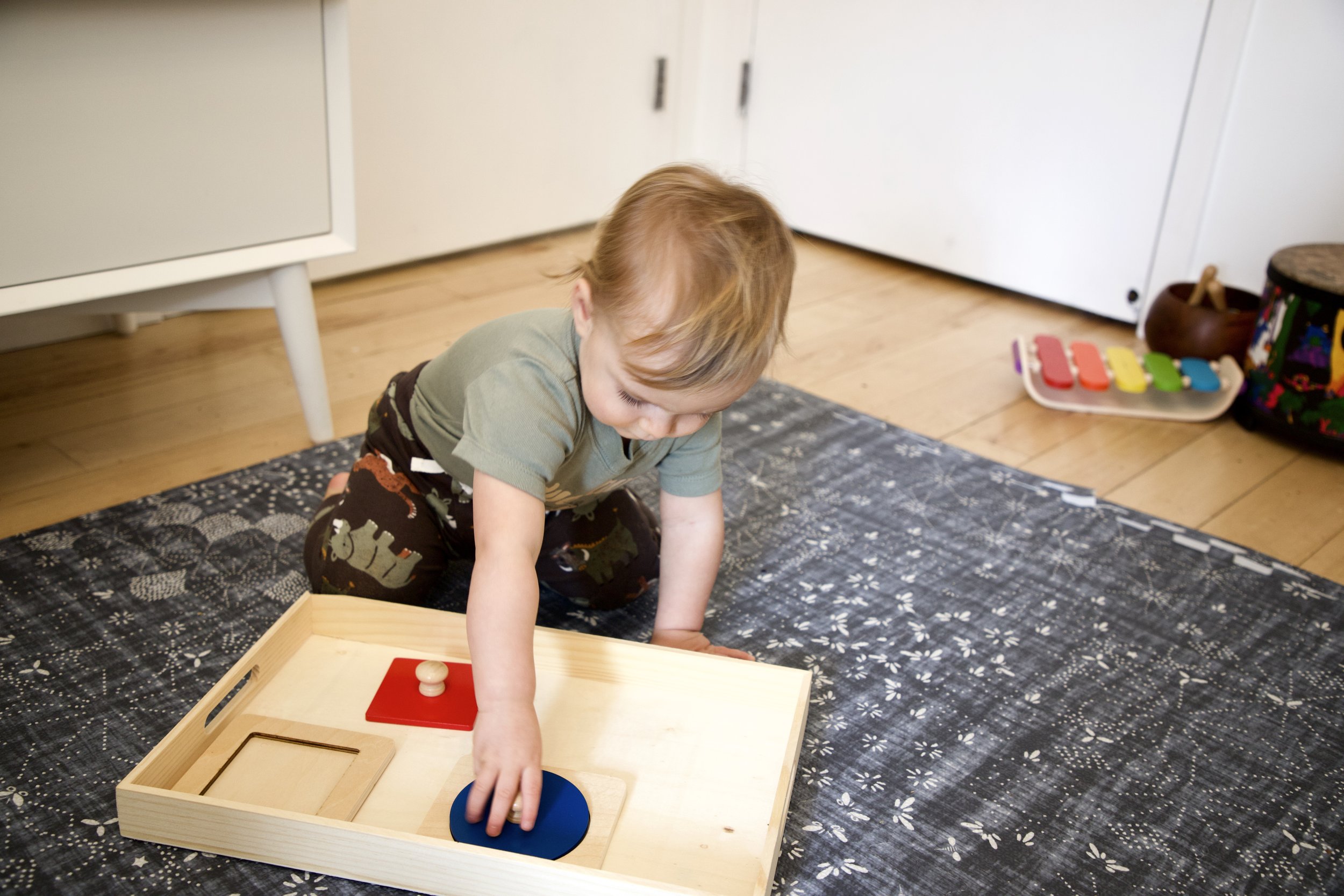Introducing Puzzles to Your Toddler: Peg Puzzles
This post may contain affiliate links, which means I may earn a small commission if you buy through my link but does not change your price.
Are you interested in introducing puzzles to your toddler or older baby but not sure where to start? Interested in what a Montessori puzzle progression might look like? You’ve come to the right place! This blog series will go through our full puzzle progression from the simplest single-piece puzzles my son started in infancy to the 48-piece puzzles he is working on now at 2. This first post covers peg puzzles (and similar inset puzzles that lack pegs).
First Puzzles
The first puzzles we introduced to my son were single-piece peg puzzles. We started with the Montessori single-piece puzzles: the simple circle, triangle, and square. I recommend beginning with the circle as it is the easiest piece then moving to the triangle and then the square. These can be introduced from late infancy though my son was not particularly interested until around his first birthday.
With these, I presented the puzzle done since he first preferred to take out the pieces and later (after his first birthday) began showing more interest in putting the puzzle back together.
We had a few of these including one with a baby’s face inside and one with a mirror inside. The classic Montessori puzzle would not have anything inside but my son preferred the ones with a face and a mirror. The mirror in particular was his favorite so I actually DIY’d the triangle and square to have a mirror like the circle mirror one we had. If you are interested in trying that as well, this is the mirror sticker I used.
Simple Multi-Piece Peg Puzzles
Once he could do the single-piece puzzles I introduced the three single-piece ones together. There are classic Montessori puzzles with three on one board but to avoid buying something new I just provided the three single-piece ones on a tray together.
Following the simple shape multipiece we introduced other simple multipiece puzzles. I did a multi-shape one at first around 13 months and found he was not yet interested. Around 15 months this one went over better. It has more shapes than just the three I introduced previously. I also introduced a multipiece circle size discrimination one at this time. He was not super into these puzzles at this point.
Increasing the Complexity
At 16 months I also introduced a vegetable peg puzzle. This puzzle was more challenging and also has smaller pegs that further refine the pincer grasp. When I first introduced it he did it but was not particularly interested. I brought it out several months later at around 20 months and he was very engaged with it at that point. Interestingly, even then he had a better time with it upside down. I don’t know why but others on Instagram experienced the same thing. So if your child is struggling with this puzzle (or any puzzle?) maybe try flipping it!
One thing to keep in mind with puzzles like this is whether there is a guide underneath or not. A guide underneath such as the vegetable one we have will be easier than one lacking a guide such as the one on the right below. Here on our vegetable puzzle, it is an exact match underneath so the child can match the pictures and not just have to match the outline. I would start with these before moving to puzzles where they just have to match the outline. An in-between stage is one with a not exact image underneath such as the fruit puzzle below.
Puzzles Without Knobs
Another type of puzzle similar to knobbed puzzles are inset-type puzzles without knobs. These are far more common than the knobbed ones so it is easier to find options that might interest your child. I do tend to prefer knobbed puzzles since they work on the pincer grasp, but these are great too and, like I said, often come in more options (and are often more affordable). A puzzle like this is actually what ignited my son’s interest in puzzles. They follow the same difficulty pattern as the knobbed puzzles.
We introduced a Melissa and Doug vehicle puzzle to him around 20 months and he was obsessed. It stayed on the shelf for months and he did it multiple times a day. I think having a puzzle that really appealed to his interests (he loves vehicles) got him interested in puzzles generally.
Once I introduced the vehicle puzzle he was very keen on trying other puzzles as well. I introduced several other inset puzzles and brought back the vegetable one which he loved at this point. He was not quite ready for ones without the guide at this point but enjoyed them several months later. This elephant puzzle, for example, was too challenging for him at 20 months but he loved it when I introduced it again a few months later.
I also extended his love for these puzzles by doing puzzle mix-ups where I would put all the pieces in a basket and spread out the puzzles. He loved this!
We have continued to introduce more challenging inset and peg puzzles such as continent ones (following his interest in maps) and his name puzzle.
Now he enjoys inset puzzles with and without a guide, including very complex ones.
In my next blog post I will be discussing 3D puzzles!







